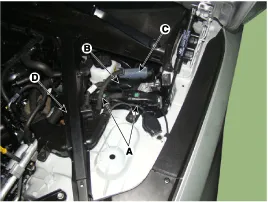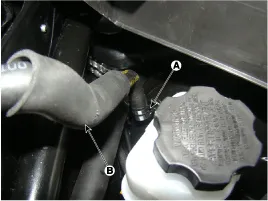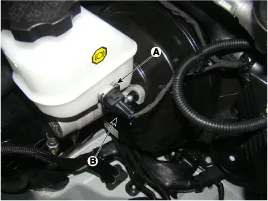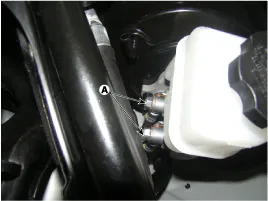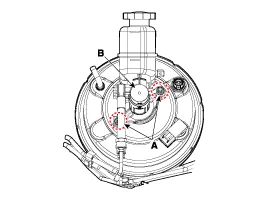Hyundai Genesis (DH): Brake System / Master Cylinder Repair procedures
Hyundai Genesis (DH) 2013-2016 Service Manual / Brake System / Brake System / Master Cylinder Repair procedures
| Removal |
| 1. |
Turn ignition switch OFF and disconnect the negative (-) battery cable. |
| 2. |
Disconnect the ECM connector (A) and TCM connector (B). IDB (C) and then remove the noise barrier (D).
|
| 3. |
Remove the Cowl Top Cover.
(Refer to Body - "Cowl Top Cover") |
| 4. |
Remove the ECM, TCM & IDB. |
| 5. |
Remove the clamp (A) and brake vacuum hose (B).
|
| 6. |
Remove the clip (A) and then disconnect brake fluid level switch connector (B).
|
| 7. |
Remove the brake fluid from the master cylinder reservoir with a syringe.
|
| 8. |
Loosen the hose connecting bolt (A) and disconnect the brake tube.
|
| 9. |
Remove the master cylinder (B) from the brake booster after loosening the mounting nuts (A).
|
| Installation |
| 1. |
To install, reverse the removal procedure. |
| 2. |
After installation, bleed the brake system.
(Refer to Brake System - "Brake System Bleeding") |
Components 1. Reservoir cap2. Reservoir3. Grommet4. Master cylinder
Other information:
Hyundai Genesis (DH) 2013-2016 Service Manual: In-car Sensor Description and Operation
Description An in-car air temperature sensor is located in the crash pad lower panel. The sensor contains a thermistor which measures the temperature of the cabin. The signal determined by the resistance value which changes in accordance with perceived inside temperature, is delivered to the heater control unit and according to this signa
Hyundai Genesis (DH) 2013-2016 Service Manual: Temperature Control Actuator Repair procedures
Inspection 1. Turn the ignition switch OFF. 2. Disconnect the temperature control actuator connector. 3. Verify that the temperature control actuator operates to the warm (Driver's side) or cool (Passenger's side) position when connecting 12V to terminal 3 and grounding terminal 4.
Categories
- Manuals Home
- Hyundai Genesis Owners Manual
- Hyundai Genesis Service Manual
- Electric Parking Brake (EPB) Repair procedures
- Body (Interior and Exterior)
- Suspension System
- New on site
- Most important about car
Copyright В© 2026 www.hgenesisdh.com - 0.0254

